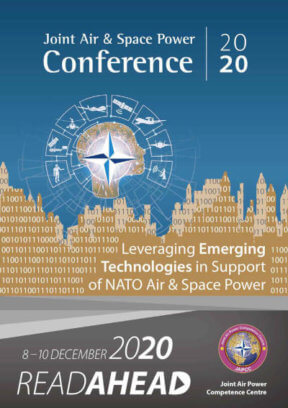Electromagnetic Spectrum Disciplines
Apart from the traditional physical domains of Air, Land, and Maritime, in the last decade NATO has also declared Space and Cyberspace as domains of operations. While Electronic Warfare (EW) used to be the traditional warfighting element of the Electromagnetic Spectrum (EMS), the 21st century has ushered in a tremendous technology revolution leading to the emergence of new advanced capabilities and functions in the EMS such as Directed Energy Weapons (DEW) and low emission radars. During this same period, Cyberspace1 has become an attractive domain of operations for power projection as well.
Both state and non-state actors demonstrated in latest Syrian conflict that the dominance in Land, Maritime, Air, Cyberspace, and Space starts with the integration and harmonization of all EM disciplines including: EW, Signal Intelligence (SIGINT), Intelligence, Surveillance, Target Acquisition and Reconnaissance (ISTAR), Navigation Warfare (NAVWAR), and Battlespace Spectrum Management (BSM). To put it simply, the EMS is the invisible physical space of waves, which bridges all domains of operations, enabling missions and supporting the campaign goals.
While NATO Strategic Foresight Analysis (SFA) highlights the complexity of the future battlefield, and NATO Future Framework for Alliance Operations (FFAO) aspires to allied forces’ dominance of the EMS, NATO leaders and planners are still considering the necessity of integrating EMS disciplines and functions under a single coherent approach. Consequently, this article will explain why NATO needs to integrate and unify all the EMS capabilities, entities and disciplines under a single domain of operations, the EMS including Cyberspace.
The Symbiotic Relationship of Electromagnetic Spectrum Disciplines
Since the invention of aircraft and during the last century passed, air operations have been touted as an essential prerequisite contributing to other domains’ successful operations in order to achieve their desired end states.
However, the latest battles in Syria and Libya highlighted that airpower is often not abundant enough to achieve the desired campaign end state by itself. The EMS functions such as the electromagnetic and cyberspace activities, were found to be the most attractive operations for power projection on the Syrian battlefield. On the one hand, the low-cost of employment, the ‘stealth’ attributes, the remote presence and posture, and the ability to fight without a defined Forward Edge of the Battle Area (FEBA) are some of the reasons for the popularity of the EMS capabilities’ on the battlefield. On the other hand, the tremendous speed of EMS-dependent applications and the numerous EMS disciplines and functions that are being employed without cohesion and coordination, contributes to a ‘blizzard’2 of EMS effects, where decision-makers might be incapable of making time-critical decisions.
NATO recognizes the EW capability as an essential tool for the full spectrum of operations and other tasks undertaken by the Alliance3 and NATO Cyberspace policy remains focused on Defensive Cyber Operations (DCO),4 as NATO has not yet embraced a concept of Offensive Cyber Operations (OCO). In contrast, the Russians demonstrated both in the Crimea annexation and in Syria that they have likely developed doctrine to employ cyberspace capabilities integrated and synchronized with EW and SIGINT activities during their military operations at all levels of war, political, strategic, operational and tactical. In particular, it is highly likely that Russia’s EW and Cyber capabilities have been merged5 under single domain of operations.
However, the ‘Alliance Joint EM Strategy’ dictates the need for synergy through greater integration of the EME core functions and related activities including those of Cyberspace and Space. The perfect example of the interdependency of EME activities, in particular the EW and Cyberspace, was clearly highlighted during a September 2007 Israeli strike on a North Korean supported nuclear weapons facility in Syria. More specific, a cyber-stealth attack was delivered by an Israeli airborne electronic attack platform which allowed Israeli forces to virtually take control of the Syrian integrated air and missile defence system, and let the ‘highly observable’ F-15s and F-16s strike aircraft penetrate the Russian-designed, modern and long-range surface-to-air missile systems of Syria.6
Furthermore, certain NATO nations have already recognized at a national level the convergence between cyberspace and EW activities7 and employed them under the concept of Cyber-Electromagnetic Activities (CEMA).8 This synergy was also effectively employed during Operation Atlantic Resolve.9,,10 Similarly, the symbiotic relationship between EW and Cyberspace operations has also been noted by near-peer competitors of NATO such as Russia, China and Iran.
In fact, Cyberspace is a part of the EMS, and it is the only domain which has been physically and virtually created by humans employing applications of the EME such as copper wires, fibre optic cables, microwave, and satellite relays. The common ground of Cyberspace operations, EW, and SIGINT activities is apparent, and it has been previously highlighted by United States (US) Army Doctrine.11 Cyberspace operations overlap with more than 50 percent of both EW and SIGINT activities; necessitating the great need for operational consolidation allowing EMS disciplines to share the same staff, processes, and technologies in order to avoid duplication of effort and to prevent working at cross-purposes.12
The High Value of the Electromagnetic Spectrum
The differences in the Libyan and Syrian conflicts could be omens which foreshadow a future in which NATO will only achieve dominance in the Land, Maritime, Air, and Space domains, while superiority is achieved in the whole EME including Cyberspace. Dominance in the EME may not be achieved unless all the EME stakeholders13 operate in a synchronized, harmonized and coherent manner with all domain owners towards the campaign’s desired end state. To put it simply, all EM disciplines and functions including Cyberspace operations need to be integrated and synchronized in order for NATO forces to be dominant in the ambiguous, increasingly complex, and contested future conflict environments.
Similarly, the Russo-Georgian conflicts’ lessons learned allowed Russia to develop tremendous and modern EW capabilities, which have been effectively employed in the Eastern Ukrainian and Syrian battlefields. In particular, the recent Russian–Ukrainian clash highlighted that employing EW and Cyberspace operations synergistically, could be a high-value and highly effective tool of operations during ‘gray zone’14 conflicts. Upon Russia’s invasion of the Crimean Peninsula, an extended array of multipurpose electromagnetic assets was established along all the territories of interest, allowing Russia to implement its strategy on creating, not only a contested, but also a congested and denial environment against adversaries’ operations. It is apparent that Electromagnetic Operations (EMO) has probably become a key element of Russia’s modern warfare doctrine, allowing it to employ deliberate actions, by proxy, in support of fulfilling its ambitions and goals against opposing nations’ pursuits during the outbreak of a ‘gray zone’ conflict.
Unifying EME stakeholders and challenging those to operate as a single task force under one policy, such as the EMO concept, may let NATO achieve its goals and desired end state during an intervention. The EMS might be a significant factor of operations when the threshold line between military and non-military actions is opaque, and intervention events could not be clearly attributed to any of the opposing forces.
Not only could EMS capabilities provide a great advantage to NATO forces against adversaries during a ‘gray zone’ conflict, but the EMS could also be rendered as a high value domain of operations that NATO political leaders and planners may employ as a tool of deterrence. Employing EMO may prevent NATO from being engaged in a lethal intervention, and shield its forces and infrastructure, while at the same time NATO forces may have the opportunity to occupy the EMS and dominate a potential adversary.
Conclusion
Apart from Russia’s resurgence, for the first time, the NATO Secretary General addressed that the rise of China also poses challenges for Alliance security and he stressed that ‘as the world changes, NATO will continue to change.’15 While the world is changing and new security challenges are arising, EMO might be a cornerstone in any future conflict, in particular, among near-peer NATO competitors. NATO adversaries have identified that EMS disciplines can be unified into a single domain of operations, rendering it as a cost effective and highly valued solution in support of their goals and strategies, as well as, their ‘gray zone’16 operations.
While NATO planners are still pursuing the utopia of Multi-Domain Operations, presently no one can be the only occupant of the EME to achieve electromagnetic dominance. However, the apparent common ground of Cyberspace, EW, and SIGINT operations necessitates that NATO should unify all of the EMS dimensions including Cyberspace, so that allies may acquire the ability to use more of the EMS, to share the EMS more efficiently, to protect our own forces’ use of the EMS, deny our opponents’ use, and achieve electromagnetic dominance in the future.









